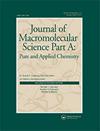ε -己内酯和δ -戊内酯开环聚合催化剂双(β -二酮酸)锆化合物HOMO和LUMO的测定
IF 2.4
3区 化学
Q3 POLYMER SCIENCE
Journal of Macromolecular Science Part A-Pure and Applied Chemistry
Pub Date : 2023-10-27
DOI:10.1080/10601325.2023.2273842
引用次数: 0
摘要
摘要聚(ε-己内酯)(PCL)和聚(δ-戊内酯)(PVL)是脂肪族聚酯,一般用于骨、牙种植材料、药物输送系统、组织工程支架等基础医用材料。PCL和PVL属于聚内酯类,具有良好的生物相容性、无毒性、柔韧性、热塑性和可控的生物降解性。这些优越的性能使其成为生产医用材料的主要选择。本研究旨在确定双(β-二酮酸)锆(IV)配合物催化PCL和PVL的聚合程度。此外,还对催化剂配合物进行了最高占据分子轨道(HOMO)和最低未占据分子轨道(LUMO)的分析。ε-己内酯(ε-CL)和δ-戊内酯(δ-VL)的开环聚合反应(ROP)在100℃下持续4 h。然后用FTIR、1HNMR、XRD、DTA和TGA对所得PCL和PVL的化学和热性能进行了表征。PCL和PVL都是半结晶的。另一方面,所得PCL的熔点为65.5℃,聚合度(DP)为17。同时,所得PVL熔点为63.4℃,DP为8。关键词:双(β-二酮酸)锆(IV)聚(ε-己内酯)聚(δ-戊内酯)开环聚合反应和植入物披露声明作者未报告潜在利益冲突。我们非常感谢Hibah Penelitian Fundamental Reguler DRTPM DIKTI RI (No. 012/UN33.8/DRTPM/PL/2023)提供的资金支持。本文章由计算机程序翻译,如有差异,请以英文原文为准。
Determination of HOMO and LUMO of bis( β -diketonate)zirconium(IV) compound used as a catalyst in the ring opening polymerization of ε -Caprolactone and δ -Valerolactone
AbstractPoly(ε-caprolactone) (PCL) and poly(δ-valerolactone) (PVL) are aliphatic polyesters that can generally be used for basic medical materials such as bone and dental implant materials, drug delivery systems, and scaffolds in tissue engineering. PCL and PVL belong to the polylactone group which have superior properties such as good biocompatibility, nontoxicity, flexibility, thermoplastic and can be biodegraded in a controlled manner. These superior properties make it the main choice in producing medical materials. This study aims to determine the degree of polymerization of PCL and PVL catalyzed using a bis(β-diketonate)zirconium(IV) complex. In addition, analysis of the Highest Occupied Molecular Orbital (HOMO) and Lowest Unoccupied Molecular Orbital (LUMO) was also carried out on the catalyst complex. The ring-opening polymerization reaction (ROP) of ε-caprolactone (ε-CL) and δ-valerolactone (δ-VL) lasted for 4 h at 100 °C. The resulting PCL and PVL were then characterized for their chemical and thermal properties using FTIR, 1HNMR, XRD, DTA and TGA. Both PCL and PVL are semicrystalline. On the other hand, the resulting PCL has a melting point of 65.5 °C, with a degree of polymerization (DP) of 17. Meanwhile, the resulting PVL has a melting point of 63.4 °C with a DP of 8.Keywords: Bis(β-diketonate)zirconium(IV)poly(ε-caprolactone)poly(δ-valerolactone)ring-opening polymerization reactionsand implants Disclosure statementNo potential conflict of interest was reported by the author(s).Additional informationFundingWe are grateful for the financial support provided by Hibah Penelitian Fundamental Reguler DRTPM DIKTI RI (No. 012/UN33.8/DRTPM/PL/2023).
求助全文
通过发布文献求助,成功后即可免费获取论文全文。
去求助
来源期刊
CiteScore
4.60
自引率
16.00%
发文量
61
审稿时长
3.1 months
期刊介绍:
Journal of Macromolecular Science, Part A: Pure and Applied Chemistry (JMS-PAC) is a necessary resource for academic and industrial scientists and engineers whose interests center on both synthetic and naturally occurring polymers and their applications.

 求助内容:
求助内容: 应助结果提醒方式:
应助结果提醒方式:


